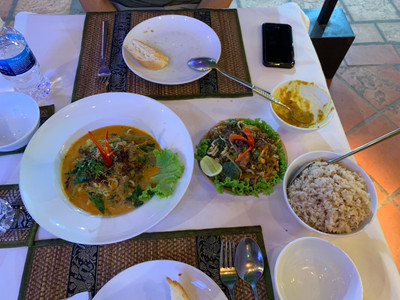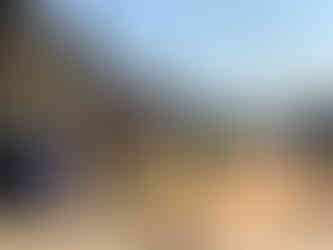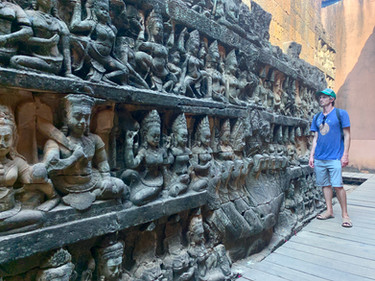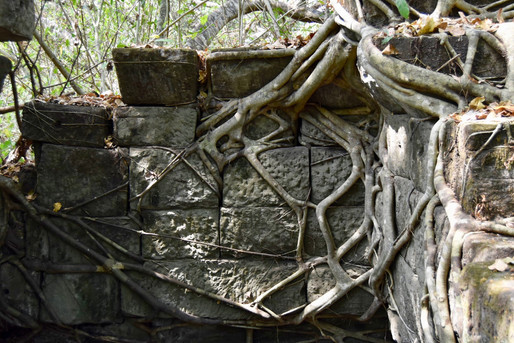Cycles of Civilization: Angkor Wat and Siem Reap, Cambodia
- tangio
- May 6, 2020
- 17 min read
Welcome to Cambodia

We had just arrived at the Cambodian border from Bangkok when a random man boarded our bus. He walked down the aisle, passing out visa forms, and everyone instinctively started filling them out. Michael, a bit skeptical about this unofficial looking guy, asked him how much the visa costs. “$40,” the man said. Michael had just read that the Cambodian visa costs $30, so he asked the man why it wasn’t that amount instead. “Well,” the man starts, “if you don’t want to use my expedited service, you can get off the bus and purchase a visa on arrival directly at the border.” “Okay, great,” we said, and handed back the papers. Everyone else on the bus heard us and proceeded to do the same. Mini scam averted.
We happily hopped out of the bus and traversed the land crossing at Poi Pet, a classic example of a crazy border town, with a casino right up against the border fence and haphazard development all around. Entering the Arrivals Hall, a large sign clearly displayed: “30 Day Tourist Visa, $30 USD.” Exactly what we thought. (Conveniently for us, Cambodia uses the U.S. Dollar. Even their ATMs dispense USD and it is the preferred currency everywhere. However, U.S. coins are not accepted, so small change is returned in Cambodian Riel. For example, if you pay $5 for something costing $2.50, you’d get back $2 USD and 2,000 Riel, which was confusing at first, but we quickly got used to it.) We walked up to the counter and handed over our passports to the immigration officer, who looked at us and said, “$33 for the visa.” “But the sign says $30,” we responded, pointing directly at the sign posted above his head. “No, $33,” he replied, smugly, “$3 processing fee.”
We had been warned about the prevalence of Cambodian border officers scamming tourists. Thus, we argued back and forth for a few minutes, but because we knew a few fellow travelers who had to pay quite a bit more to get through, we decided it wasn’t worth the fight for just $3. However, Michael only had 60 Thai Baht (around $2) left on him, so we gave the officer our remaining Baht with the old “that’s-all-we-have-left” trick, and that was sufficient for him. We got the visas, jumped back on the bus, and entered Cambodia. A good travel lesson here is to always hide most of your money when negotiating/bribing!
As we drove another couple hours across the flat countryside, passing endless rice paddies and small villages, we wondered if our next two weeks in Cambodia were going to consist of trying to dodge small cons at every turn, as our first hour had shown. We’re happy to report that they did not, as everyone else we met in Cambodia was extremely friendly, kind, and honest. That especially held true with the all the hostel staff and drivers we met in Siem Reap, our first stop in country to explore the famous Angkor Wat.
Siem Reap is a fascinating town. With a population of almost 140,000 people and many more tourists at any given time, it features French colonial and Chinese-influenced architecture, with a hotbed of good international and local restaurants alike, and a strong nightlife. Indeed, there is a whole area called “Pub Street,” brimming with live music and drunk tourists. There are rechargeable motorbikes next to local craft markets and tourist stores selling everything from high end art to cheap $1 t-shirts (which everyone actually seems to buy, because every tourist seemingly ends up wearing the same elephant screen print shirt by their third day in Siem Reap). One can choose to eat either French-Cambodian fusion vegan (which we did) or an entire meal of bugs (which we did not—we’re not sure if it was because of the bugs themselves or because we scoffed at the prices at the fancy bug restaurant; seriously, how can tarantula skewers or marinated scorpions over green papaya salad cost $9 each—a small fortune in Cambodia?!). Both should be finished with the decadent homemade gelato in town. And no matter how many times we passed by the Cambodian boxing ring with a live show every night, we could not help but laugh at the cheesy emcee, with his shirtless abs and strong American accent trying to lure us in, not unlike the young Cambodian girls outside the massage parlor around the corner doing the same.
Immediately outside of town, though, rural farmland runs in all directions, dotted by villages that depend on the seasonal freshwaters of nearby Tonlé Sap Lake for their livelihood. There is almost no transition between the bustle and the expanse. Never has the line between a tourist town, sustained only because it sits next to one of the wonders of the world, and “real local life” been as clear as it was in Siem Reap and its surrounding area. We don’t always like many of these very touristy towns, but Siem Reap had enough self-awareness about its own kitsch that we were mostly fans. Oh, and we loved our hostel.
That’s right, Onederz Hostel is a model backpacker establishment. It is by far the largest hostel we’ve ever stayed in, with ~180 beds spread across three buildings. And it was almost entirely full, so the place was packed with 25-year-old backpackers from around the world; it was truly a wonder (!) that the staff could deal with everyone’s needs! Onederz was also one of the best designed hostels we have ever stayed in. It has quality modern finishes and is well-maintained and clean, obvious hallmarks of a good hostel. Plus, it featured a cafe that served decent food and smoothies, a bar, a rooftop pool, ample common space to facilitate meeting others, and organized group events daily. But it’s really the little appointments that satisfy a traveler’s needs—a personal light and charging outlet to use behind your own privacy curtain in your bunk bed, a jug of drinking water to fill up your bottle, and a lot of useful hooks in the room—that makes it a great place to stay. The travelers and operations managers in us loved it.
History of Angkor
Large size coupled with small fine details are also what makes Angkor Wat, meaning “City of Temples,” one of the greatest wonders of the world. (“Angkor Wat” is the name of a specific temple—the most famous one in the city—but it is also used interchangeably as the name for the entire ancient city of Angkor, as well.) Angkor Wat, the city, is not just the largest religious site in the world—with hundreds of temples dedicated to Hindu gods, in addition to some Buddhist shrines built in the latter years of the city’s reign—but it was also the largest pre-industrial city in the world, encompassing 400 square kilometers and once home to an estimated one million people. The temples that fill its grounds are grand, with tall stone towers reaching toward the sky and sprawling complexes stretching out in all directions that look as big as the Pentagon. Despite the impressive size of the ancient city and its remaining structures, though, it is their precise proportions, their symmetry, and the stories told through their detailed bas relief carvings that truly make Angkor Wat an incomparable work of art.
Angkor was the capital city of the Khmer Empire, which rose to power in Southeast Asia in the 800s AD. To celebrate their independence from Java, the king built a Hindu temple to honor the gods. Over the years, subsequent kings extended the empire, controlling what is today Cambodia, along with southern Vietnam, parts of Laos and Thailand, and at times extending as far as Burma and Malaya, building temples at every turn. In addition to honoring gods, kings also built temples to honor themselves and their family, with planned tombs for their final resting places. As we also saw in Central Asia’s swelling mausoleums and minarets, new rulers often felt the need to outdo those who came before them, so the temples became bigger and grander as time went on.
To enable this, a comprehensive public works system was put into effect to construct the temples and city—likely using forced labor. Massive reservoirs, called barays, were dug around most temple complexes for a number of reasons: for defensive purposes, creating a moat around the buildings; as a source of water for irrigation; and to keep the underlying sand moist, retaining its concrete-like structure in order to support the large sandstone buildings sitting above it. Similar effort was expended to bring in building materials. Looking around Angkor, there isn’t a mountain in sight; the terrain is basically flat. Thus, the rocks for the temples were quarried from a hillside 50 km away, then floated down a river to arrive at Angkor. In order to carry them to their final locations, holes were drilled into the massive boulders, dimples that can still be seen on many stones today. Traipsing across the large city, it is hard not to be dumbfounded by the sheer scope and execution of the Khmer’s vision.
In the 12th century, the city of Angkor was sacked when the Cham people from southern Vietnam revolted. The Khmer eventually regained control and countered by erecting Angkor Thom, a massive walled city bigger than Angkor Wat and containing the famed Bayon Temple at its center. The king who built Angkor Thom actually switched from Hinduism to Buddhism, possibly because he felt the need to test a different spiritual protector after the previous Cham defeat. But Buddhism wouldn’t save Angkor. The Thais who came in the 14th century destroyed Angkor and captured the western part of Cambodia where the city lies (it was returned to Cambodia only in 1907, with the help of the French), forcing the Khmer to move their capital across the country to Phnom Penh, where it remains today.
Visiting Angkor Archaeological Park, with so much to see and learn, can be daunting. But we ended up happy with the roundabout way we spent our three days there. Not wanting to get up early for sunrise on our very first day after the long bus ride from Bangkok, we skipped Angkor Wat that morning (which is what most people visit first) and instead embarked on the “Grand Circuit” in the afternoon, which encompasses some of the lesser known temples, including Preah Khan, Neak Pean, Ta Som, East Mebon, and Pre Rup. This was a great warmup to what Angkor had to offer. On day two, we went even farther afield, joining up with a few fellow travelers from Onederz to visit two amazing sites located outside the old city, Beng Mealea and Banteay Srei. That meant that we saved the main highlights, Angkor Wat, Angkor Thom and Bayon, and Ta Prohm, for our third and final day. The lead-up was well worth it.
Intro to Angkor
We’re not sure if we loved it simply because it was the first temple we visited in Angkor, but Preah Khan is spellbinding. One of the largest temples in the city, it was likely the home of the king building the new city of Angkor Thom, around the end of the 12th century.
As we crossed a moat and entered the north gate of the complex, we passed a long series of stone busts representing a tug of war between the gods and demons, fighting for the body of a serpent. This scene is called the “Churning of the Ocean of Milk,” which is recreated on the walls and murals of many of the temples, including Angkor Wat and Angkor Thom. Upon entering, we were treated to equal parts majestic archways and large piles of rock, exquisite carvings and faded reliefs that have been weathered away with time. There was a menagerie of sandstone, lichen, and moss. Preah Khan is in the process of being restored, so while we saw some of its grandeur and superb details, much of it remains in ruins, which we believe is interesting in its own right. It exhibits the newer of the two principal Khmer architectural styles—the “galleried temple,” which features single-story structures laid out in long columned hallways forming the axes of a temple. Because it is “newer,” Preah Khan was also built around the time when the Khmer were dabbling back and forth between Hinduism to Buddhism. Thus, three of its four entrance gates are dedicated to Hindu deities—Shiva, Vishnu, and Brahma—with the last entrance dedicated to Buddha. The fluidity between the Hindu and Buddhist religions during the same time period fascinated us, and it also speaks to how these belief systems successfully spread across Southeast Asia, typically weaving in elements of the native animist practices in order to attract followers. While Buddhism ultimately won out in Southeast Asia, it is not uncommon to see Hindu deities in Buddhist temples even today (Buddha himself was born a Hindu).
After Preah Khan, we continued in our little tuk-tuk tour bus for four—with two other girls, an American from Denver named Lily and a German from Berlin named Jana—and hit up Neak Pean, a small shrine built on a small island in the middle of an expansive baray, and Ta Som, known for its massive fig trees engulfing its temple gates. We ended our day at East Mebon and Pre Rup, two temples that showcase the earlier Khmer design, the “temple-mountain,” which consists of a series of terraces stacked on top of one another in pyramid-like fashion, crowned with five towers up top (one in the center plus the four corners around it), pointing toward the heavens. These temple-mountains are meant to architecturally represent Mount Meru, the home of the Hindu gods, while the surrounding moat represents the ocean. We climbed up to the top of both, walking past large stone statues of elephants and garudas (mythical birds) while the late afternoon light cast a subtle orange glow over the sand bricks.
While none of the temples we visited on the first day are considered “must-sees” if one only has limited time, we basically had them all to ourselves (except for sunset at Pre Rup), which really allowed us to appreciate their beauty in quiet exploration.
Beauty in the Breakdown
The next day, we hopped into our car and headed out of Siem Reap. Well, it wasn’t exactly our car from San Francisco, but it was the exact same look and model: the 2002 champagne-colored Lexus RX300. For some reason, there are countless of these early to mid-2000s SUVs all over Cambodia. It’s as if all the American suburban soccer moms shipped their used cars out here once they decided to collectively switch to Subarus. We sat comfortably in the back of the Lexus as Dara, a Onederz staffer moonlighting as our driver on his day off, drove us out into the Cambodian countryside, along with Lily again and a new friend, Thijs from the Netherlands, to discover the less-visited gems of Beng Mealea and Banteay Srei.
Pulling up to Beng Mealea today resembles what the French must have felt when they “discovered” Angkor Wat in the 1860s. A dense jungle hides the remains of the once great temple. Much of the temple galleries are a pile of rubble that looks like a shaken-up 3-D jigsaw puzzle, pieces of etched rocks and appendages of stone statues strewn about. Giant trees reach over broken walls like the invading Thai, and roots of the fig tree wedge themselves between building blocks, slowly and successfully prying them apart. Carvings above doorways are obscured by overgrown vines. We walked by all this on wooden platforms suspended above the ruins, as collapsed archways prevent access into the interiors, and conservationists want to prevent even further deterioration. And yet, for an 800-something-year-old structure, much of Beng Mealea is still surprisingly intact, such as sections of hallways with roofs still spanning the columns, and fragments of bas relief carvings of dancing apsara that still appear clear as day. It reminded us of the aftermath when one accidentally steps on a Lego castle—75% of it gets completely destroyed, while some sections are missed by the foot entirely and remain untouched.
Besides being able to play Indiana Jones for the day, the other fascinating aspect about visiting Beng Mealea is that we got to see Angkor Wat for what it really is: an unresolved mystery. Most of what we read about why the Angkor temples were built or who they were for are just hypotheses (albeit informed ones), as there is still so much archaeological exploration that needs to take place across the vast city to truly understand the ancient Khmer civilization. Restored temples are really just an interpretation of what modern scholars think the temples look liked; without photos or blueprints as a guide, there is no way to know for sure. But Beng Mealea, still in piles of raw ruins, is unfiltered and real. In fact, because it has the same floorplan as Angkor Wat, Beng Mealea is arguably more telling of the original 12th century Angkor Wat than visiting actual Angkor Wat today, which was restored by Buddhist monks in the 16th century.
That doesn’t mean the rebuilt temples aren’t impressive. In fact, Banteay Srei, a small, simple structure that was one of the first to be restored by the French, ended up being Michael’s favorite of all the Angkor temples. The breadth and depth of its carvings, etched into the distinctive orange and pink sandstone, are simply beautiful. Three dimensional carvings of religious scenes depicting Shiva and apsaras drape over doorways, and the walls are graced by chariots and elephants, serpents and lions, flowers and ocean waves. Sanskrit scriptures are engraved onto the columns and doorframes, while robust monkey statues guard the entrances. Banteay Srei means “Women’s Temple,” as it is believed that a man’s hand was too big to produce such finely detailed carvings. We’re not sure if we agree with the logic, but either way, it’s hard not to be in awe of the portrait-like art sculpted out of the hard rock, or not to be stunned by the work it took to rebirth the temple, after seeing what other sites look like in their natural deteriorated state today.
Cycling Around Ancient Civilizations
On our third and final day in the archeological park, we woke up at 4:15am and headed out in the gray-dark of early morning. In the pleasantly cool air, we easily biked the seven kilometers from central Siem Reap to Angkor Wat temple. Other than a local morning market beginning to stir, the ride was quiet and peaceful. As we approached the famous wonder, with the first trace of light barely starting to curve over the horizon, we could make out the faint silhouettes of the renowned Angkor Wat towers, their distinctive jagged edges similar to the image that graces the country’s national flag. At the same time, we could also see the outline of many other cars and tuk-tuks and their passengers, all heading to Angkor Wat for the beautiful, but notoriously touristy, sunrise over the mythical temple.
Sunrise at Angkor Wat is a bucket list item that you do because everyone else is doing it, but it’s honestly not so special. Look, it is certainly picturesque to watch the morning break and wash over the temple, but it’s not necessarily unique or exclusive—as it might be at certain ancient Aztec or Mayan marvels, cosmically engineered such that the sun rays will geometrically line up with the steps of a pyramid, forming serpents that spit sun-fire right at the exact moment of the equinox (are our standards getting too high?). The real problem with the Angkor Wat sunrise is not the sunrise nor the grounds—which are indeed phenomenal—it’s that everyone is fighting to get the same photo of the temple’s reflection in a tiny pond located near the entrance, making the area very congested (and this was just as coronavirus was taking off in Cambodia!). We saw tourists slowly creeping forward to get a better view, with some photographers basically standing in the first couple inches of the water in order to be in front of the others. People got testy. Hilariously, as the sun was rising, a man quietly walked across the other side of the pond, in clear view of the cameras but not disturbing anything. A woman suddenly yelled out at the top of her lungs, in that distinctive American accent and attitude, “Move out of the way, you’re ruining the photo!!” Her screech pierced the morning silence like nails on chalkboard; not surprisingly, it was far more disturbing than the man’s shadow in our photos. Once both view and mood were ruined, Michael ventured away from the pond and found a quieter spot on the other side of the entrance, which was a much more pleasant way to experience the sunrise. Karen was short enough to get in front of people while avoiding fist fights, so she caught a few decent photos before heading away, as well.
Then, as suddenly as the woman’s scream interrupted the peace, things went quiet again. After the sun peaked out behind the towers, almost all the tourists left to go visit the other temples on the main circuit. We had our own wheels, so we were on our own schedule, and thus were able to stick around and finally get unobstructed views of the towers reflecting in the pond, with the ball of fire only slightly higher in the sky than it was at sunrise. Our next few hours were blissful as we found ourselves almost alone with Angkor Wat. We walked the long lengths of the grounds, cartwheeled through the courtyards, and took the time to carefully admire every single bas relief, which filled the space with intrigue and narrative as deep as each of the long hallways themselves.
Architecturally and artistically, Angkor Wat is a true masterpiece—even monks were taking selfies with it, for Buddha’s sake! The grounds are massive, with over 200 acres enclosed by a five-kilometer-long wall, making it the largest religious building in the world. It seamlessly combines both of the Khmer styles, featuring the five temple-mountain towers in the middle—the central one reaching 150 feet high—surrounded by narrow, symmetrical galleries on all sides that measure almost half a mile long in total. The colonnades almost give Angkor Wat a slight European feel, at times resembling a government building or a college campus more than a temple. On the other hand, the bas reliefs carved into the entire circumference of the outer galleries certainly reflect Khmer. These walls tell cherished stories of good versus evil, as large armies march off to fight demons, with the Hindu gods of Shiva and Krishna featured prominently. We happened to go on a Buddhist holiday, so monks where there giving ceremonial blessings to visitors, a curious scene in a temple adorned with Hindu heroes.
Having spent all morning at Angkor Wat, we enjoyed an early lunch that featured surprising entertainment component—a trio of feral cats taking on a large snake (it ended in stalemate, with the cats forcing the snake back up a tree). Hopping back onto our bikes, we were grateful for the pedal-assist now that the sun was high in the sky and beating down on us fiercely. We survived the heat by rehydrating with fresh coconuts every couple hours, appreciating the ability to visit the temples on our own time and pace.

And we would need that time at our next stop: Bayon, the central temple inside the second city of Angkor Thom. From afar, Bayon almost looks pixelated from the way the stones are stacked, so we half expected Bowser from Mario Brothers to pop out of the stone castle. But as one gets closer, the many blurry spires come into focus as images of faces—216 stone faces, to be exact, peering down on us from all angles and levels, visible from every corner and nook of the temple grounds. Because most of the other statues and carvings around Angkor consist of mythical creatures, the mortal-like faces of Bayon cast a unique energy to the ancient city. Their slight smiles and knowing smirks made our exploration there playful one minute and contemplative the next—but always alive with their glare and wisdom. The fact that historians don’t know for sure the exact story behind the faces makes them all the more mysterious. Are they hypnotic because they represent the faces of gods, or because they understand us as friends? All we know is that Bayon’s ability to achieve both humanity and holiness at once, makes it one of the more powerful sites within the park.

Many of the other temples located within the walls of Angkor Thom are less famous but often similarly mesmerizing. We crossed the long causeway entrance to Baphuon, taking in the vistas from the top (the reward for climbing some very narrow and steep steps); we scaled the ruins of Prasat Preah Palilay, which were barely visible through the thick jungle brush until we were right in front of it; we witnessed locals using the Terrace of the Leper King and Terrace of the Elephants as backdrops for wedding photos. Then, as the heat began to soften in preparation for twilight, we biked over to our last temple: the legendary ruins of Ta Prohm.
Ta Prohm is deservingly one of everyone’s favorite temples in the whole Angkor complex. Like Beng Mealea, Ta Prohm is a scene out of Indiana Jones—or, more accurately, out of Tomb Raider, the Angelina Jolie movie that actually filmed at the jungle temple, giving it the very creative nickname, the “Tomb Raider Temple.” Its celebrity ties and untamed grounds attract huge crowds, especially in the mornings, when we were told that visitors have to wait in line just to get a glimpse of certain trees. Because we visited so late in the day, though, we luckily encountered very little traffic, accompanied only by the whisper of wind blowing through the massive trees and the eerie crumble of stone as we stepped over rubble.
Enormous banyan and strangler fig trees have swallowed up the bastions of Ta Prohm, overturning stones and crushing stupas. The fig trees appear as alien invaders, their feet-like roots stepping over the high stone walls to enter, while the banyans drape their aerial roots over the temple like a spider’s web. We wandered through fallen corridors, barely held up by haphazard beams and supports that will inevitably also succumb to the unforgiving trees in due time. There, alone in the jungle, the mind questions whether the thick roots resembling anacondas snaking up columns aren’t real reptiles lurking about, camouflaged in the bowels of the temple. Overtaken by these strangling fig trees, blankets of lichen, and the passage of time, Ta Prohm’s crumbling facades are a great reminder that no matter how grand a civilization is and how high its rise, they will all fall one day. The power of human creation is strong, but so is its power to destroy—and Mother Nature still reigns supreme, stronger than both at reclaiming the earth back.
And yet, the Hindu belief of reincarnation is not so far off, for the temples of Angkor have indeed risen again and come back to life for us to witness. One cannot help but feel this energy, the vitality of those whose hands carved the stones and who literally moved mountains to build this world, for Angkor Wat truly lives up to its billing as one of the great wonders of the world. This notion of rebirth would stay with us the rest of our time in Cambodia, as the Khmer civilization is rising again today after another tragic, and more recent, fall.
Karen & Michael
Siem Reap, Cambodia, February 5-9, 2020




























































































































































































Comments